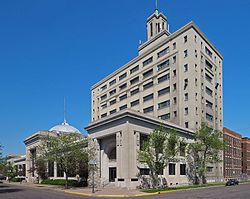Watkins Incorporated

Multi tool use
This article is written like a personal reflection, personal essay, or argumentative essay that states a Wikipedia editor's personal feelings or presents an original argument about a topic. (February 2015) (Learn how and when to remove this template message) |
J. R. Watkins Medical Company Complex | |
U.S. National Register of Historic Places | |
 The J. R. Watkins Headquarters from the southwest | |
 Show map of Minnesota  Show map of the US | |
| Location | 150 Liberty Street, Winona, Minnesota |
|---|---|
| Coordinates | 44°2′58″N 91°37′41″W / 44.04944°N 91.62806°W / 44.04944; -91.62806Coordinates: 44°2′58″N 91°37′41″W / 44.04944°N 91.62806°W / 44.04944; -91.62806 |
| Area | 2.5 acres (1.0 ha) |
| Built | 1900–1914 |
| Architect | George W. Maher |
| Architectural style | Prairie School (1911 Administration Building) |
| NRHP reference # | 84003940[1] |
| Added to NRHP | December 4, 2004 |
Watkins Incorporated is a manufacturer of health remedies, baking products, and other household items. The entire catalog includes 400 products. It is based in Winona, Minnesota, United States, which utilizes an Omni channel marketing strategy which includes a national retail sales force which focuses on selling to the retail channel as well as an independent sales force of 25,000 people to distribute its products. This independent sales force sells the products using various methods, including the Internet, person to person, trade shows, party planning, and fund-raising. In order to increase overall awareness for the brand, the company began offering products in national retail outlets such as Walmart, Target, Walgreens, Kroger and other mass, drug and grocery retail stores in 2005.
The company was founded by J. R. Watkins in Plainview, Minnesota, who began selling liniment in 1868 door-to-door in the southeastern part of the state. The company moved to Winona in 1885 and added a number of products to its lineup. Baking materials including pepper and vanilla extract were added in 1895. J. R. Watkins died in 1911.

The "finest private administration building in the world" printed on postcard mailed in 1915
By the 1940s, Watkins was the largest direct-sales company in the world, but soon began to decline. The demographics and buying habits of the United States had major shifts in the following decades, and the company did not keep pace. Watkins filed for bankruptcy protection in the 1970s, and was purchased by Minneapolis investor Irwin L. Jacobs in 1978.
In 1996, Jacobs' son, Mark Evan Jacobs, began to take over day-to-day operations of the company. He was 14 at the time his father purchased the company, and had worked as a Watkins salesman for many years. The younger Jacobs was an aspiring actor, appearing in minor roles in films like Biloxi Blues and Goodfellas, but he realized that his acting career wasn't advancing. Since taking over the reins, he has controlled spending, introducing an enhanced compensation plan for sales associates, along with an extensive brand study that led to the introduction of products onto store shelves for the first time.
Wal-Mart has carried Watkins products since 2003 other stores nationwide, including Cub Foods, Rite Aid, Walgreens, CVS, Giant, Stop & Shop, Wakefern, Hannaford, Whole Foods, Pick 'N Save, Schnucks, Hy-Vee, New Seasons Market food stores, Harris Teeter, Target, Menards, Home Depot and others are carrying select items, including spices and extracts as well as some personal care items, liquid hand soaps, home cleaning and the original remedies from the company's beginning. The reception from the retail community has been strong. A new all-natural line of personal care products were introduced to the retail community in the spring of 2008 and has quickly gained market share against Burt's Bees and others. A home cleaning line that is all-natural debuted at Target and rolled out nationally in the 2nd half of 2008 and is now sold throughout the country.

Watkins Complex seen from the south
The seven-building Watkins headquarters in Winona is on the National Register of Historic Places as the J.R. Watkins Medical Company Complex. It was listed in 2004 for having national significance in the themes of architecture, commerce, and industry.[2] It was nominated for being the longtime headquarters of the nation's largest direct sales company in the early 20th century, and for the Prairie School design of its 1911 Administration Building by architect George W. Maher.[3] The front entrance includes a window designed by stained-glass artist Louis J. Millet depicting Sugar Loaf, a local landmark.
In 2002 the story of a Watkins salesman, Bill Porter, was dramatized in the TNT movie Door to Door. He worked a route despite suffering from cerebral palsy.
See also
- National Register of Historic Places listings in Winona County, Minnesota
References
^ National Park Service (2010-07-09). "National Register Information System". National Register of Historic Places. National Park Service..mw-parser-output cite.citationfont-style:inherit.mw-parser-output qquotes:"""""""'""'".mw-parser-output code.cs1-codecolor:inherit;background:inherit;border:inherit;padding:inherit.mw-parser-output .cs1-lock-free abackground:url("//upload.wikimedia.org/wikipedia/commons/thumb/6/65/Lock-green.svg/9px-Lock-green.svg.png")no-repeat;background-position:right .1em center.mw-parser-output .cs1-lock-limited a,.mw-parser-output .cs1-lock-registration abackground:url("//upload.wikimedia.org/wikipedia/commons/thumb/d/d6/Lock-gray-alt-2.svg/9px-Lock-gray-alt-2.svg.png")no-repeat;background-position:right .1em center.mw-parser-output .cs1-lock-subscription abackground:url("//upload.wikimedia.org/wikipedia/commons/thumb/a/aa/Lock-red-alt-2.svg/9px-Lock-red-alt-2.svg.png")no-repeat;background-position:right .1em center.mw-parser-output .cs1-subscription,.mw-parser-output .cs1-registrationcolor:#555.mw-parser-output .cs1-subscription span,.mw-parser-output .cs1-registration spanborder-bottom:1px dotted;cursor:help.mw-parser-output .cs1-hidden-errordisplay:none;font-size:100%.mw-parser-output .cs1-visible-errorfont-size:100%.mw-parser-output .cs1-subscription,.mw-parser-output .cs1-registration,.mw-parser-output .cs1-formatfont-size:95%.mw-parser-output .cs1-kern-left,.mw-parser-output .cs1-kern-wl-leftpadding-left:0.2em.mw-parser-output .cs1-kern-right,.mw-parser-output .cs1-kern-wl-rightpadding-right:0.2em
^ "Watkins, J. R., Medical Company Complex". Minnesota National Register Properties Database. Minnesota Historical Society. 2009. Retrieved 2015-06-23.
^ Frame III, Robert M. (August 1984). "National Register of Historic Places Inventory—Nomination Form: J.R. Watkins Medical Company Complex". National Park Service. Retrieved 2015-06-29.
- Chris Serres (December 18, 2005). Winona's Watkins takes leap from door to store. Star Tribune.
Erdman, Sandy (5 May 2012). "For Watkins, it all began here". Post Bulletin. Retrieved 2 February 2015.
Hughlett, Mike (15 December 2013). "Watkins extracts and spices make headway into grocery stores". Star Tribune. Retrieved 2 February 2015.
External links
- Official Website
- Architectural overview of the J.R. Watkins Medical Products Company headquarters, 1911-13.
- "George Washington Maher - architect for the headquarters building"
VKdFpNYLNXsCaeC07,BI7h CaJ9YMoRJLH9B,HzOfWLp,k kb,S9uID 12wKc 1NwQ1kiepPa,IsnQ,9W0wrynWLYv0

